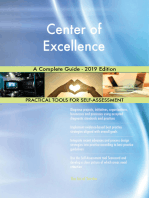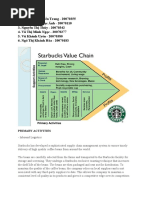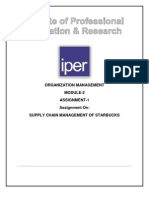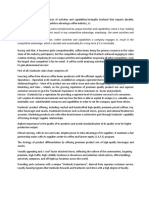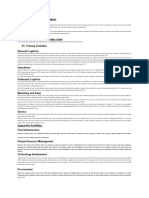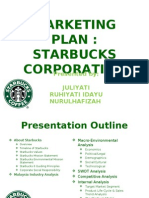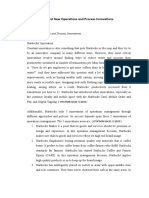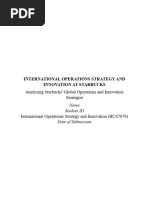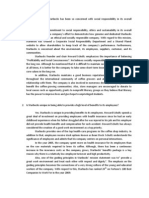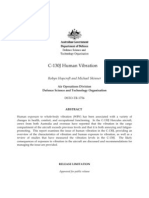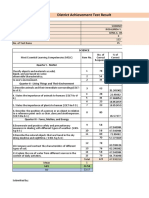JMP 6213: Supply Chain Management: Universiti Utara Malaysia
JMP 6213: Supply Chain Management: Universiti Utara Malaysia
Uploaded by
MayLeng TanCopyright:
Available Formats
JMP 6213: Supply Chain Management: Universiti Utara Malaysia
JMP 6213: Supply Chain Management: Universiti Utara Malaysia
Uploaded by
MayLeng TanOriginal Title
Copyright
Available Formats
Share this document
Did you find this document useful?
Is this content inappropriate?
Copyright:
Available Formats
JMP 6213: Supply Chain Management: Universiti Utara Malaysia
JMP 6213: Supply Chain Management: Universiti Utara Malaysia
Uploaded by
MayLeng TanCopyright:
Available Formats
Universiti Utara Malaysia
JMP 6213: Supply Chain Management
Lecturer: Professor Dr. Premkumar Rajagopal
Prepared by: Soon Chee Hong Rosni Ab Rahim Tan May Leng Lim Soon Yu Koe Siew Chan 802435 807817 807821 808696 810xxx
Table of Contents
1.0 Company Background
2.0 Starbucks Supply Chain Management Characteristics
4-5
3.0 Coffee Supply Chain Process
4.0 Stakeholders Analysis
7-8
5.0 Starbucks Sustainability Phase Model Analysis
8-10
6.0 Recommendations
10-11
7.0 Summary
11
Reference
12
1.0
Company Background Starbucks is an international coffee company and coffeehouse chain starts in Seattle in
1971. The company buys coffee beans from around the world and roasts, blends and sells fresh, rich- brewed, Italian style espresso beverages, a variety pastries confections and coffee related accessories and equipment primarily through company-operated retails outlet. In addition, the company also sells whole bean coffees through specialty sales group and supermarkets. The company's objective is to establish Starbucks as the most recognized and respected brand in the world. All employees of Starbucks is working towards one common goal set as the company mission statement and apply the below given guiding principles in their oprations.
Starbucks currently have more than 17,000 stores in over 55 countries worldwide. A total of 149,000 employees worldwide company has set up its mission not only to serve finest coffee, but
also providing a great working environment for employee and create positive impact to communities they served. Starbucks has consistently ranked as one of 100 Best Companies To Work For for 1998-2000 and 2002-2010 and is also recognized as one of the Global 100 Most Sustainable Corporations in the World by Corporate Knights in 2010 for its positive effort towards its employee, communities and environment.
2.0
Starbucks Supply Chain Management Characteristics: To understand how Starbuck customize the initiatives to fits its business it is important to
understand the characteristics of its supply chain. Below are the characteristics that supporting Starbucks supply chain management.
2.1
Two way information flows: Starbucks uses several targeted internal communication tools to educate partners about these efforts and to encourage them to help. The company communicates through its weekly Scoop operations bulletin that goes to all retail stores, plus the monthly Sirens Tale newsletter, which is distributed throughout the entire organization. Starbucks also disseminates internal information online via its Partner Portal. For major announcements of environmental programs, Starbucks executives use the company-wide voicemail system. At Starbucks, internal communication is a two-way channel. Mission Review, an on-going opportunity for partners to provide feedback on projects or programs at Starbucks, allows partners to question whether a decision, action or program adheres to the Starbucks Mission Statement or Guiding Principles.
4
2.2
Customer service: The managers at Starbucks put tremendous attention into hiring good people people. People who enjoy interacting with and pleasing others. Their hiring and training process is designed systematically to produce events as described above. It isnt an accident. It isnt left to chance. And its part of why they win.
2.3
Supply Chain Relationships: Starbucks actively supports the sustainable production of coffee through its C.A.F.E. (Coffee and Farmer Equity) Practices program, which is a supplier program that promotes improvements in product quality, economic transparency, social responsibility and environmental leadership at the producer level. The Cocoa Practices is designed to enhance buying companies ability to work with a diversity of suppliers to foster deeper sustainability throughout the cocoa supply chain from farm to factory to final product. Ultimately, the goal of the scoring system is to establish a long-term relationship with preferred suppliers by awarding the strategic supplier with better pricing or financial premium (share reward), eliminating uncertainty and volatility (or share risk) of prices that dominates the industry.
2.4
Inventory: There is no clear indication of the Starbucks in term of the supply chain Pull or Push systems, but, by referring to the nature business of the Food and Beverage (F&B), I believe Starbucks is using the push system to promote the varieties of the products to the downstream market. Nevertheless, in accordance to the strong participation of Starbucks under the C.A.F.E. program, the visibility of the supply
5
chain upstream networks is much easier as the partnership among the farmers or producers until it reach Starbucks, are recorded under the C.A.F.E indicator and will be evaluated by the 3rd parties in the yearly basis. In additional, the entire supply chain network is managed by the 3rd party logistic (3PLs) company to handle the shipment for the global distribution centers. 2.5 Landed Cost: In referring to the Starbucks C.A.F.E. (Coffee and Farmer Equity) Practices program towards the supply engagement towards the entire supply chain to build the long term strategic supplier, Starbucks can have a good coordination of supply chain activities which may lower the landed cost. The long term customersupplier relationship was built and evaluated yearly to further establish and develop the 2nd tier of suppliers in the future. The Starbucks C.A.F.E. which promote the share rewards or risks towards the suppliers will further improve the supplier participation in the overall supply chain costing, including the landed cost.
3.0
Coffee Supply Chain Process Supply chain is the sequence of activities and processes required to bring a product from
its raw state to the finished goods sold to the consumer. It takes a well-run supply chain to ensure that a barista pours a good cup of Starbucks coffee. That's because the journey from bean to cup is a complicated one, which includes several activities such as coffee planting, cultivation, harvesting, extraction, selection, roasting, blending, grinding, packaging and finally turns into a
cup of coffee that are enjoyed by many. Coffee and other merchandise must be sourced from around the globe and then successfully delivered to the Starbucks Corporation's retail stores. To ensure effective supply chain, Starbuck have reorganized its supply chain structure and simplify it to fall into the four basic supply chain functions: plan, source, make, and deliver. Starbuck also have developed an efficient distribution model to enable the distribution of the coffee beans to its processing plants, with the goal of manufacturing in the region where the product is sold. As part of Starbuck sustainability effort initiated C.A.F.E. (Coffee and Farmer Equity) Practices to evaluate, recognize, and reward producers of high-quality sustainably grown coffee. C.A.F.E. Practices is a green coffee sourcing guideline developed in collaboration with Scientific Certification Systems (SCS), a third-party evaluation and certification firm. C.A.F.E. Practices seeks to ensure that Starbucks sources sustainably grown and processed coffee by evaluating the economic, social and environmental aspects of coffee production against a defined set of criteria, as detailed in the C.A.F.E. Practices Guidelines. C.A.F.E Practices also enable smallholder coffee farmers to sell their beans directly to importers, roasters and retailers at favorable guaranteed prices by eliminating few middlemen layers.
Starbuck also implemented GPS tracking system using the RFID technology to track cargo containers used to ship coffee after the suppliers drop off raw materials at the designated collection centers. This system is use to monitor its shipment progress to Starbucks joint roasting plants till they gather in the distribution center and later distributed to its licensed stores, outlets and its joint business partners, like supermarkets and grocery stores.
4.0
Stakeholders analysis: Stakeholders are individuals or organization who are actively involved in the
organization and whose interest may be positively or negatively affect the result of the company. Stakeholder analysis is important as through this analysis we can understand what stakeholders want from the company and what are the companys expectations towards them. But having deeper understanding with stakeholders, the company can then develop engagement strategies to gain their interest and support In this study, we will focus Starbucks stakeholder analysis to five of its key stakeholders, which are shareholders, employee, retailers, customers and coffee farmers. Shareholders and employees are internal stakeholders while retailers, customers and coffee farmers are external stakeholders. In this study we measured Starbucks stakeholders based on 4 dimensions which is power, commitment, interest and impact. Power is defined as the stakeholders ability to influence company decision, commitment measuring the stakeholders obligation to the company, interest depicts the level of concern towards the company decision/performance and lastly, impact measures the effect of their actions towards the company. The table below shows the measurement of the stakeholders and their degree of power, commitment, interest and impact to Starbucks. Shareholders have high power because they can easily influence the companys decisions. They have high commitment and high interest because the well being of the company will ensure that they get good returns. For big shareholders, if they decide to sell their shares, this may impact the company ie. Change in management.
8
Employees have low power because they cannot easily influence the strategic decisions of a company. However, they have high commitment and interest in the companys well being because it will influence their future development and job security. Employees have high impact on the company because they are the working force and if any union or strike occurs it may cripple the companys day to day operations. Coffee farmers are the main suppliers of Starbucks. They have high power because Starbucks is dependent on them to provide consistent supply of good quality beans. On the other hand, they have high interest and commitment to Starbucks because Starbucks provide consistent demand to the coffee farmers and take care of their well-being through programs such as the C.A.F.E. Coffee farmers have high impact to Starbucks because they can choose to supply Starbucks competitors if they are not happy with the business agreement with Starbucks. Retailers have high power and high impact because they are the end of Starbucks supply chain and are directly dealing with Starbucks customers. Hence the service provided by retailers will reflect on Starbucks company image. They have high commitment and interest in Starbucks decision because it will also influence their business decisions ie. promotions and CSR efforts. Lastly, Starbucks customers have high power and impact to the company. Customers can influence the decisions of Starbucks because they can demand what they want and Starbucks will try to fulfill customer needs in order to make profit. They also have high impact because the switching cost to other coffee providers is almost free. Customers have no commitment or interest in the companys well being because there are other alternatives which can provide coffee.
Stakeholder Chart The table below lists down Starbucks main stakeholders, what they contribute to the company, what they expect from the company and what the company expects from them. The table below also lists the strategic implications that these stakeholders have over Starbucks.
Now that Starbucks understands its stakeholders and its stakeholders strategic implications over the company, Starbucks can think of ways to keep them engaged. Keeping stakeholders engaged will benefit the company by ensuring loyalty, morale, close collaboration
10
etc. There are certain communications strategies that Starbucks can adopt to engage its stakeholders such as face to face interactions and focus groups. This will ensure Starbucks include them in decision making that involves or impacts them. For example, Starbucks can include coffee farmers in focus groups to discuss decisions about C.A.F.E. This will make the coffee farmers feel that they are part of the decisions and also ensure their voice is heard. It is also important for Starbucks to create a communication channel for customer feedbacks. This way the company and gage the market trends and if their products are pleasing the customers. Starbucks can collaborate with its retailers to rollout strategic programs to ensure that they are aligned on the company goals and direction in these programs. This is especially on the CSR programs that Starbucks is trying to achieve. Without the corporation from its retailers, it would not be possible. To ensure engagement and loyalty from its employees, Starbucks should empower them and involve them in the companys decision making. All these are examples of engagement strategies Starbucks can take on to manage their stakeholders well and as a result all stakeholders who are fully engaged will be interested to help make Starbucks supply chain flawless.
5.0
Starbucks Sustainability Phase Model Analysis In todays business environment, supply chain sustainability is increasingly recognized as
a key component of corporate responsibility. Sustainability is key maintaining the integrity of a brand, ensuring business continuity and managing operational costs. It helps to create, protect and grow long-term environmental, social and economic value for all stakeholders involved in bringing products and services to market.
11
At Starbucks, its sustainability programs are also known as Social Responsibility. The mission statement is to inspire and nurture the human spirit one person, one cup and one neighborhood at a time. They believed that businesses should have a positive impact on the communities they serve. So ever since the first store in 1971, Starbucks dedicated to earn the trust and respect from customers, partners and neighbors by being responsible and doing things that are good for the planet and each other.
Starbucks Social Responsibility breaks down to 4 main areas listed below:
12
Starbuck sustainability phase model falls under phase5, strategic proactively. The mix and diversity are seen as integral and vitally important aspects for the business. Intellectual and social capitals are used to develop strategic advantage through innovation. Proactive and seek for stakeholders to involve environmental strategies supporting ecological sustainability are seen as strategic business opportunities to provide competitive advantage. The organization seeks competitive leadership through spearheading environmentally friendly products and processes.
6.0
Recommendations Even though Starbucks is running the business in a good shape, nevertheless, there are
some recommendations which cover different areas like Corporate Social Responsibilities; Product & Service and Marketing Strategies.
13
6.1
Corporate Social Responsibility Starbucks face challenges to achieve 25% reusable cup serve in store by year 2015. As of Y2010, the reusable cup serve is 1.8%, vs 2009 1.5%. Major challenges are due to 17,000 stores in over 55 countries world wide. Different countries have difference practice/focuses on recycling. Our group recommendation on this is to have more campaign to promote customer awareness in recycling. Beside, Starbucks could also provide more attractive compensation for customer who use recycle cup. This will help to encourage and promote reusable cup usage at the store.
6.2
Product & Service Related Areas Starbucks could try to extend its menu selection to include drinks related to particular cultures. For example, the Chinese culture products which focus more on tea than coffee by introducing boba, a drink that incorporates little balls of jelly called tapioca while introduce more Matcha (green tea) latte and Frappuccino based in Japan. Besides, Starbucks should increase the varieties of the bottle drinks like bottled Frappuccinos which is available in supermarkets and specialty stores, which remain extremely popular among consumers. In additional, Starbucks should increase the childrens drinks that aim to be a family environment and cater the needs of all family members, including bakery or cookies for children and etc.
14
6.3
Market Strategies Related Areas The market strategies recommended to Starbucks are offer mini-meals; increase worldwide existence and localized products rates. Firstly, increase the mini-meals set combo would encourage the working group to buy the snacks or meals during the daily busy schedule. Besides, Starbucks need to improve the products by aligning it to the local market rates in order to capture bigger groups of the populations. Lastly, Starbucks can increase the popularity of the company products towards more rural or outskirts areas which can be reach by allocating the vending machines around the said areas
7.0
Summary Starbucks is progressively improving since its downfall in 2008. In 2011, for the first
time, Starbucks was ranked 22nd in the Gartner Supply Chain Ranking. According to Gartner, Starbucks is transforming its supply chain into a strategic differentiator. According to our group observation, Starbucks has a very strong Sustainability Strategy, if they continue to take strides in this area they will protect and grow long-term environmental, social and economic value for all stakeholders.
15
Reference http://en.wikipedia.org/wiki/Starbucks http://www.gartner.com/id=1709016 www.starbucks.com http://starbucks.com.my/en-US/_Social+Responsibility/ http://www.starbucks.com/thebigpicture http://inhabitat.com/all-starbucks-cups-will-be-recyclable-or-reusable-by-2015/ Starbucks Global Responsibility Report Goals & Progress 2010 From bean to cup: How Starbucks transformed its supply chain By JAMES A. COOKE Q4 2010 "Starbucks Corporation: Overview". Hoovers.
16
You might also like
- Operations Management Assignment Starbucks CorporationDocument5 pagesOperations Management Assignment Starbucks CorporationPRIYANSHA GARGNo ratings yet
- 10 OM Decisions Starbucks CoffeeDocument3 pages10 OM Decisions Starbucks CoffeeHamza Bin Tahir100% (1)
- Case #23 StarbucksDocument2 pagesCase #23 Starbuckssueysuey62No ratings yet
- Starbucks Final WriteUpDocument28 pagesStarbucks Final WriteUpAsbini SitharamNo ratings yet
- Thinespary Sitharam 851007106016 Logistic Supply Chain Management - AssignmnetDocument32 pagesThinespary Sitharam 851007106016 Logistic Supply Chain Management - AssignmnetAsbini SitharamNo ratings yet
- Case Study 3: Starbucks Corporation: Building A Sustainable Supply ChainDocument5 pagesCase Study 3: Starbucks Corporation: Building A Sustainable Supply Chainneha reddyNo ratings yet
- Final Task Performance in Supply Chain Managemen1Document7 pagesFinal Task Performance in Supply Chain Managemen1Norly LocsinNo ratings yet
- Supply Chain Management of Starbucks: 1. ReorganizeDocument6 pagesSupply Chain Management of Starbucks: 1. ReorganizeFadillah LubisNo ratings yet
- Value Proposition (21330)Document11 pagesValue Proposition (21330)Prasansha ShresthaNo ratings yet
- Case Study 36 37Document7 pagesCase Study 36 37shazma rahimNo ratings yet
- Starbucks Purchasing ManagementDocument6 pagesStarbucks Purchasing ManagementnajihahNo ratings yet
- STARBUCKSDocument12 pagesSTARBUCKSaudreyclaire.escalonaNo ratings yet
- Starbucks CoffeeDocument32 pagesStarbucks Coffeebusinessdatabases100% (2)
- Pom A1.1Document27 pagesPom A1.1ye yeNo ratings yet
- Ac 526 Stakeholder AnalysisDocument3 pagesAc 526 Stakeholder AnalysisViancaPearlAmoresNo ratings yet
- Starbucks CaseDocument19 pagesStarbucks CaseReuben EscarlanNo ratings yet
- Value Chain StarbuckDocument4 pagesValue Chain StarbuckThùy NguyễnNo ratings yet
- Starbucks Purchasing Story ExplanationDocument2 pagesStarbucks Purchasing Story ExplanationKween PhoebeNo ratings yet
- Starbucks Case StudyDocument8 pagesStarbucks Case StudywordsawwNo ratings yet
- Dion MacrooDocument9 pagesDion MacrooAyumi DamianNo ratings yet
- STARBUCKSDocument14 pagesSTARBUCKSSai Vasudevan100% (1)
- MAINTENANCE and RECOMMENDATION STARBUCKSDocument4 pagesMAINTENANCE and RECOMMENDATION STARBUCKSfizul18320No ratings yet
- OM Report StarbucksDocument3 pagesOM Report StarbucksSanya BansalNo ratings yet
- Starbucks ReportDocument6 pagesStarbucks Reportagarwalharsh2341No ratings yet
- Operations and CRMDocument3 pagesOperations and CRMNguyễn BìnhNo ratings yet
- CaliforniaSupplyChainAct tcm137-70076Document3 pagesCaliforniaSupplyChainAct tcm137-70076Albenis ReyesNo ratings yet
- Case Study StarbucksDocument11 pagesCase Study StarbuckssmarikaNo ratings yet
- AkashKumarNayak SubmissionDocument10 pagesAkashKumarNayak SubmissionAkash NayakNo ratings yet
- Starbucks Case StudyDocument7 pagesStarbucks Case StudyGlaiza PatocNo ratings yet
- AkashKumarNayak SubmissionDocument10 pagesAkashKumarNayak SubmissionAkash NayakNo ratings yet
- Starbucks Supply Chain AnalysisDocument10 pagesStarbucks Supply Chain Analysisallow closeNo ratings yet
- Starbucks Supply Chin AnalysisDocument9 pagesStarbucks Supply Chin AnalysisMohammad Osman Goni0% (1)
- Starbuck Case StudyDocument2 pagesStarbuck Case StudysahuanNo ratings yet
- StarbucksDocument14 pagesStarbucksSai VasudevanNo ratings yet
- Assign 4 - Motivating Partners at StarbucksDocument2 pagesAssign 4 - Motivating Partners at StarbucksJandrei Ezekiel LausNo ratings yet
- Management Information System (MIS) - StarbucksDocument10 pagesManagement Information System (MIS) - StarbucksManisha Jain100% (7)
- 3Document6 pages3harikacherukuri6602No ratings yet
- PorterDocument1 pagePorterTharindu WeerasingheNo ratings yet
- STARBUCKS (Internal and External Factors-Marketing) NotesDocument5 pagesSTARBUCKS (Internal and External Factors-Marketing) Noteslalla.lilli026No ratings yet
- Marketing Plan: Starbucks Corporation: Presented By: Juliyati Ruhiyati Idayu NurulhafizahDocument116 pagesMarketing Plan: Starbucks Corporation: Presented By: Juliyati Ruhiyati Idayu Nurulhafizahruhiyatiidayu100% (2)
- Group Project On Starbucks PHI401 Section: 11: Lecturer Department of History and Philosophy North South UniversityDocument26 pagesGroup Project On Starbucks PHI401 Section: 11: Lecturer Department of History and Philosophy North South UniversityAhmed DipuNo ratings yet
- Meghan Mcgowan Professor Gervais Case #3 4/2/12: Starbucks CorporationDocument13 pagesMeghan Mcgowan Professor Gervais Case #3 4/2/12: Starbucks Corporationasdefence50% (2)
- Operations StrategyDocument4 pagesOperations Strategysulabhagarwal1985No ratings yet
- Starbucks CaseDocument3 pagesStarbucks CasemehdiNo ratings yet
- Types of Supply ChainsDocument6 pagesTypes of Supply ChainsJosé SalazarNo ratings yet
- Chain ValueDocument6 pagesChain ValueAnkita T. MooreNo ratings yet
- Current and New Operations and Process Innovations AldiDocument3 pagesCurrent and New Operations and Process Innovations AldiReyfaldi Aulia OctaviandiNo ratings yet
- Tangina TP Sa StratDocument83 pagesTangina TP Sa StratJohn Phillipp MacaraigNo ratings yet
- International Operations Strategy and Innovation at StarbucksDocument14 pagesInternational Operations Strategy and Innovation at Starbucksbhatiasahil2401No ratings yet
- Starbucks SuccessDocument2 pagesStarbucks SuccessMary Anne Loseo100% (2)
- 03 Performance Task 1Document3 pages03 Performance Task 1SherylNo ratings yet
- Strabucks Essay Competitive AdvDocument2 pagesStrabucks Essay Competitive AdvalfredoenriquepreciadoNo ratings yet
- Starbucks Supply ChainDocument4 pagesStarbucks Supply ChainPrakatish P RNo ratings yet
- Coffee Colossus Starbucks Has Developed A Supply Chain That Spans 19 Countries and Funnels Everything From Cups To Coffee Beans Into Nearly 20Document14 pagesCoffee Colossus Starbucks Has Developed A Supply Chain That Spans 19 Countries and Funnels Everything From Cups To Coffee Beans Into Nearly 20Anonymous 9Gg5baonzTNo ratings yet
- A Manual for Agribusiness Value Chain Analysis in Developing CountriesFrom EverandA Manual for Agribusiness Value Chain Analysis in Developing CountriesNo ratings yet
- Affiliate Marketing and Digital Product Creation: A Beginner’s Blueprint to Online SuccessFrom EverandAffiliate Marketing and Digital Product Creation: A Beginner’s Blueprint to Online SuccessNo ratings yet
- A Comprehensive Guide to Collecting, Analyzing, and Utilizing Customer FeedbackFrom EverandA Comprehensive Guide to Collecting, Analyzing, and Utilizing Customer FeedbackRating: 3 out of 5 stars3/5 (1)
- Exercise No. 1 AccountingDocument2 pagesExercise No. 1 AccountingKristine Joy Ebrado100% (3)
- Forearm Compartment SyndromeDocument19 pagesForearm Compartment SyndromenaufalNo ratings yet
- Intersex & Ambigous Genitalia Pediatric UrologyDocument26 pagesIntersex & Ambigous Genitalia Pediatric Urologyhayssam rashwanNo ratings yet
- Skube 2018Document5 pagesSkube 2018RafaelNo ratings yet
- Macro Module 1 CompleteDocument93 pagesMacro Module 1 CompleteGAURAV BHARDWAJNo ratings yet
- Daftar Harga Obat: Antasida DOEN Tablet Antasida DOEN SyrDocument9 pagesDaftar Harga Obat: Antasida DOEN Tablet Antasida DOEN SyrifwanNo ratings yet
- Halogenacion de AlcanosDocument34 pagesHalogenacion de AlcanosAlejandra EcheverriNo ratings yet
- Part-I: Competency-Based Medical and Dental CurriculumDocument1 pagePart-I: Competency-Based Medical and Dental CurriculumSyed Muhammad AzfarNo ratings yet
- People of The Philippine vs. CastilloDocument1 pagePeople of The Philippine vs. CastilloEthan Kurby100% (1)
- Green Plastics: Poly-Lactic Acid Synthesis From Waste Tamarind Seed Powder & Its ApplicationsDocument6 pagesGreen Plastics: Poly-Lactic Acid Synthesis From Waste Tamarind Seed Powder & Its ApplicationsEditor IJTSRD100% (1)
- HOWMET AEROSPACE - Mairoll Product BrochureDocument3 pagesHOWMET AEROSPACE - Mairoll Product BrochureTaner DemirelNo ratings yet
- Paediatric Guidelines Croup 2020Document4 pagesPaediatric Guidelines Croup 2020nimraNo ratings yet
- Cocoa GeneralDocument11 pagesCocoa Generaljuan martin100% (1)
- Dan Lok Fu MoneyDocument2 pagesDan Lok Fu MoneyAneesh NbNo ratings yet
- DSTO-TR-1756 Vibrations Human EffectDocument43 pagesDSTO-TR-1756 Vibrations Human Effectsanto_tangoNo ratings yet
- Veritas Pharmaceuticals LTD: TO: Management Associates CC To: Honorable Chairman & Honorable VC &CEODocument19 pagesVeritas Pharmaceuticals LTD: TO: Management Associates CC To: Honorable Chairman & Honorable VC &CEOdidarNo ratings yet
- Lo 4 M 5 SX 5Document5 pagesLo 4 M 5 SX 5Kartikey ShuklaNo ratings yet
- 7.radiation Protection and Regulatory Aspects 02-04-2024Document52 pages7.radiation Protection and Regulatory Aspects 02-04-2024aeromac33No ratings yet
- Particle Analysis at The Touch of A Button: Litesizer™Document12 pagesParticle Analysis at The Touch of A Button: Litesizer™Tank TopNo ratings yet
- Checklist - Before Departure - Engine Room: Vessel: DateDocument1 pageChecklist - Before Departure - Engine Room: Vessel: DateДмитрийNo ratings yet
- Case Study Orangina Schweppes Final and ApprovedDocument3 pagesCase Study Orangina Schweppes Final and ApprovedRaonaNo ratings yet
- Lesson Plan Cot 2Document2 pagesLesson Plan Cot 2Catherine Plaza RososNo ratings yet
- Dat Science Item Analysis Sominot 2Document16 pagesDat Science Item Analysis Sominot 2Rosalinda Velasco PitogoNo ratings yet
- How To UnClog Your SoftTop DrainsDocument5 pagesHow To UnClog Your SoftTop DrainsPaul JohNo ratings yet
- S/N Name of Merchant / Hawker Stall Trade of Services/goods Address Unit NumberDocument106 pagesS/N Name of Merchant / Hawker Stall Trade of Services/goods Address Unit Numberalice gohNo ratings yet
- Makes: Ingredients For Gobi Manchurian RecipeDocument6 pagesMakes: Ingredients For Gobi Manchurian RecipeR P NNo ratings yet
- Chocolate GarnishDocument23 pagesChocolate GarnishClary Breganza HaliliNo ratings yet
- Vebs PDFDocument8 pagesVebs PDFAniruddha DaluiNo ratings yet
- Jyotish 1886 Chamatkar ChintamaniDocument207 pagesJyotish 1886 Chamatkar Chintamanipitchumani100% (1)
- Multi Year Training and Exercise PlanDocument54 pagesMulti Year Training and Exercise Plananne0521No ratings yet



